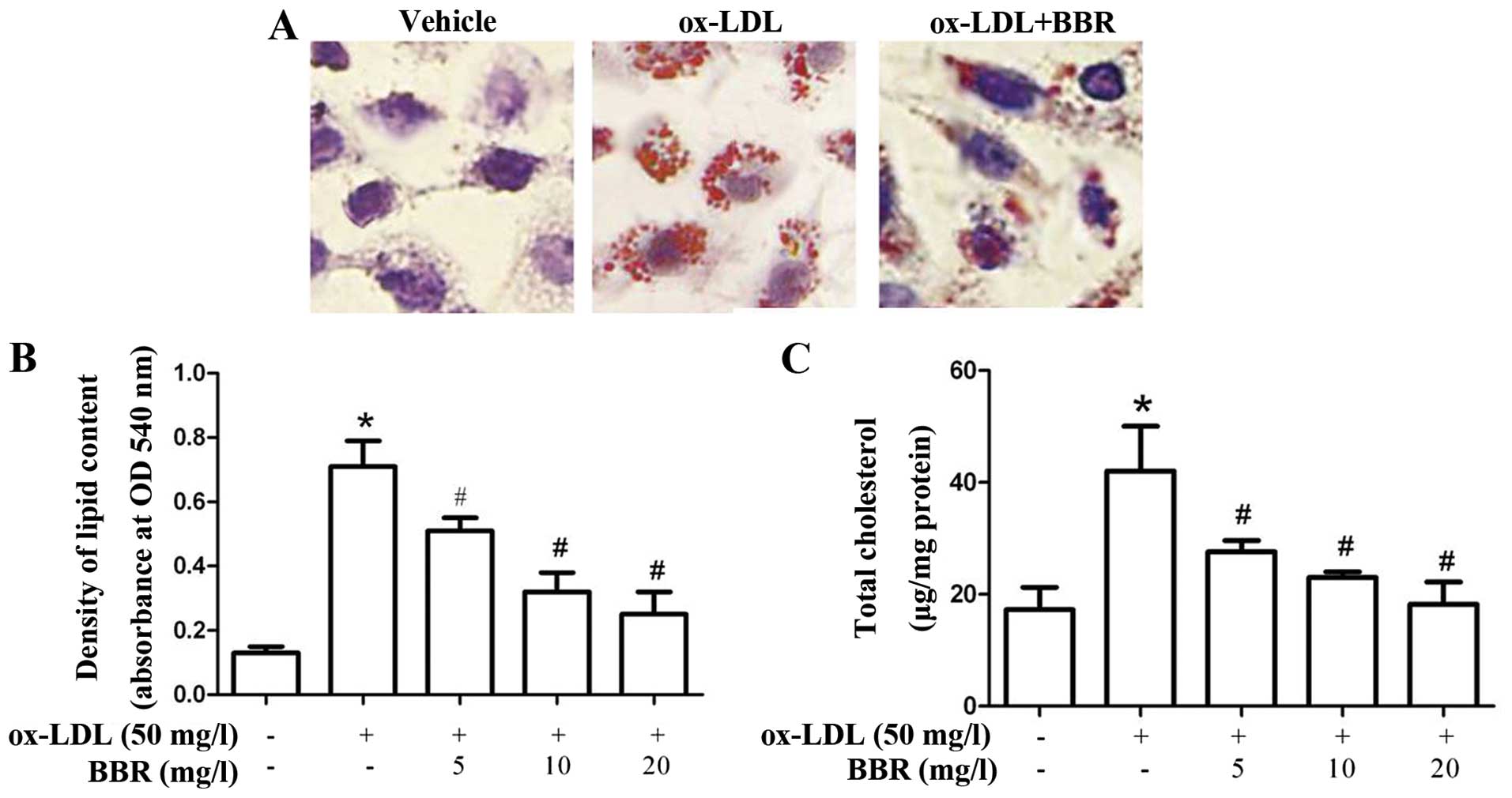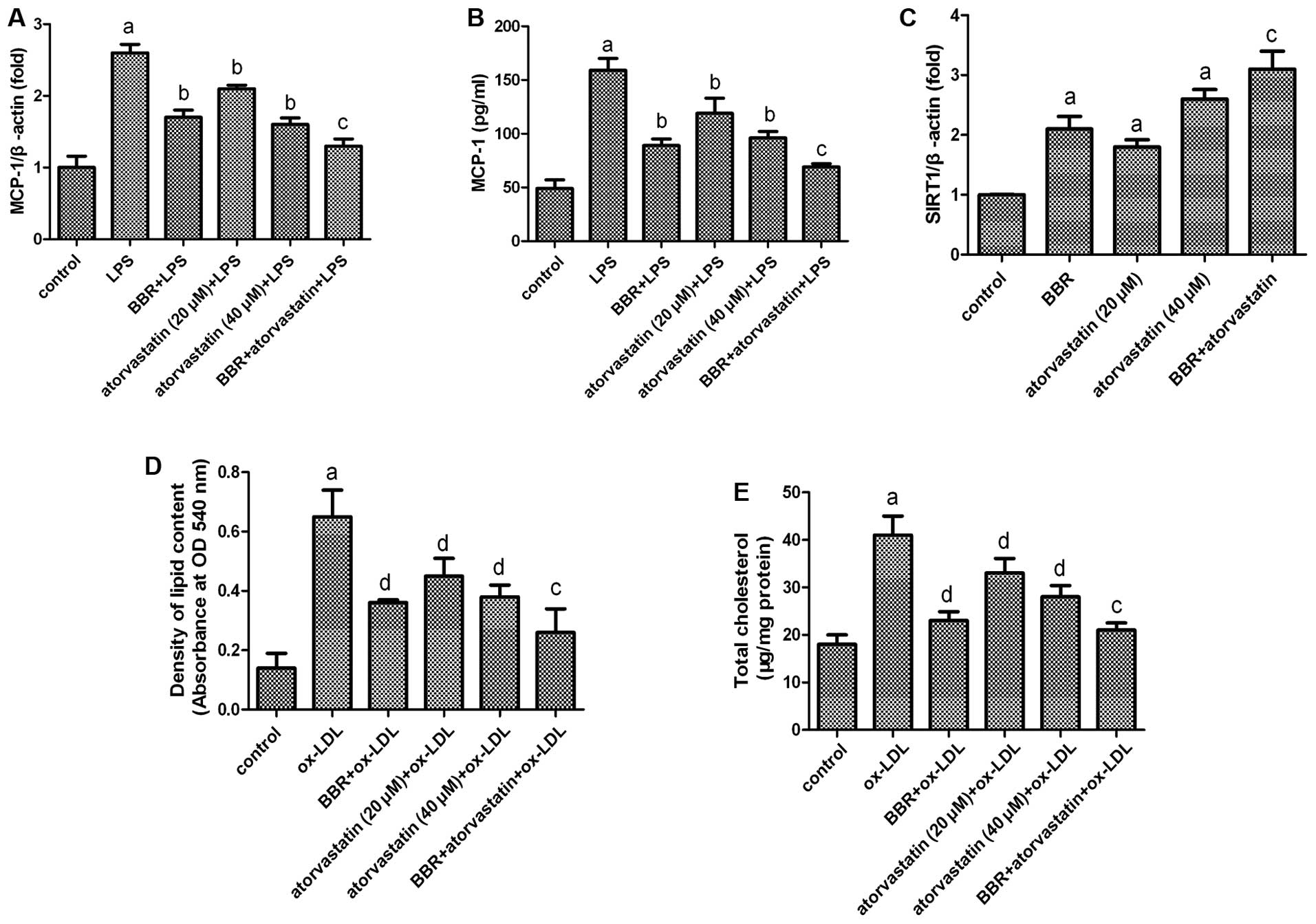|
1
|
Zhao JF, Jim Leu SJ, Shyue SK, Su KH, Wei
J and Lee TS: Novel effect of paeonol on the formation of foam
cells: promotion of LXRα-ABCA1-dependent cholesterol efflux in
macrophages. Am J Chin Med. 41:1079–1096. 2013.PubMed/NCBI
|
|
2
|
Hansson GK: Inflammation, atherosclerosis,
and coronary artery disease. N Engl J Med. 352:1685–1695. 2005.
View Article : Google Scholar
|
|
3
|
Weber C, Zernecke A and Libby P: The
multifaceted contributions of leukocyte subsets to atherosclerosis:
lessons from mouse models. Nat Rev Immunol. 8:802–815. 2008.
View Article : Google Scholar : PubMed/NCBI
|
|
4
|
Boring L, Gosling J, Cleary M and Charo
IF: Decreased lesion formation in CCR2−/− mice reveals a
role for chemokines in the initiation of atherosclerosis. Nature.
394:894–897. 1998. View
Article : Google Scholar : PubMed/NCBI
|
|
5
|
Edfeldt K, Swedenborg J, Hansson GK and
Yan ZQ: Expression of toll-like receptors in human atherosclerotic
lesions: a possible pathway for plaque activation. Circulation.
105:1158–1161. 2002.PubMed/NCBI
|
|
6
|
Li AC and Glass CK: The macrophage foam
cell as a target for therapeutic intervention. Nat Med.
8:1235–1242. 2002. View Article : Google Scholar : PubMed/NCBI
|
|
7
|
Voloshyna I, Hai O, Littlefield MJ,
Carsons S and Reiss AB: Resveratrol mediates anti-atherogenic
effects on cholesterol flux in human macrophages and endothelium
via PPARγ and adenosine. Eur J Pharmacol. 698:299–309.
2013.PubMed/NCBI
|
|
8
|
Stein S, Lohmann C, Schafer N, et al:
SIRT1 decreases Lox-1-mediated foam cell formation in
atherogenesis. Eur Heart J. 31:2301–2309. 2010. View Article : Google Scholar : PubMed/NCBI
|
|
9
|
Picard F, Kurtev M, Chung N, et al: Sirt1
promotes fat mobilization in white adipocytes by repressing PPAR-γ.
Nature. 429:771–776. 2004.PubMed/NCBI
|
|
10
|
Vaziri H, Dessain SK, Ng Eaton E, et al:
hSIR2(SIRT1) functions as an NAD-dependent p53 deacetylase. Cell.
107:149–159. 2001.PubMed/NCBI
|
|
11
|
Zhang QJ, Wang Z, Chen HZ, et al:
Endothelium-specific overexpression of class III deacetylase SIRT1
decreases atherosclerosis in apolipoprotein E-deficient mice.
Cardiovasc Res. 80:191–199. 2008. View Article : Google Scholar : PubMed/NCBI
|
|
12
|
Huang Z, Dong F, Li S, et al:
Berberine-induced inhibition of adipocyte enhancer-binding protein
1 attenuates oxidized low-density lipoprotein accumulation and foam
cell formation in phorbol 12-myristate 13-acetate-induced
macrophages. Eur J Pharmacol. 690:164–169. 2012. View Article : Google Scholar
|
|
13
|
Kong W, Wei J, Abidi P, et al: Berberine
is a novel cholesterol-lowering drug working through a unique
mechanism distinct from statins. Nat Med. 10:1344–1351. 2004.
View Article : Google Scholar : PubMed/NCBI
|
|
14
|
Yin J, Xing H and Ye J: Efficacy of
berberine in patients with type 2 diabetes mellitus. Metabolism.
57:712–717. 2008. View Article : Google Scholar : PubMed/NCBI
|
|
15
|
Liu X, Li G, Zhu H, et al: Beneficial
effect of berberine on hepatic insulin resistance in diabetic
hamsters possibly involves in SREBPs, LXRα and PPARα
transcriptional programs. Endocr J. 57:881–893. 2010.PubMed/NCBI
|
|
16
|
Zhu X, Guo X, Mao G, et al:
Hepatoprotection of berberine against hydrogen peroxide-induced
apoptosis by upregulation of Sirtuin 1. Phytother Res. 27:417–421.
2013. View
Article : Google Scholar : PubMed/NCBI
|
|
17
|
Guan S and Wang B: Effects of fosinopril
and valsartan on expressions of ICAM-1 and NO in human umbilical
vein endothelial cells. Chin Med J (Engl). 116:923–927.
2003.PubMed/NCBI
|
|
18
|
Winnik S, Stein S and Matter CM: SIRT1 -
an anti-inflammatory pathway at the crossroads between metabolic
disease and atherosclerosis. Curr Vasc Pharmacol. 10:693–696. 2012.
View Article : Google Scholar : PubMed/NCBI
|
|
19
|
Vingtdeux V, Chandakkar P, Zhao H, Davies
P and Marambaud P: Small-molecule activators of AMP-activated
protein kinase (AMPK), RSVA314 and RSVA405, inhibit adipogenesis.
Mol Med. 17:1022–1030. 2011. View Article : Google Scholar : PubMed/NCBI
|
|
20
|
Fullerton MD, Steinberg GR and Schertzer
JD: Immunometabolism of AMPK in insulin resistance and
atherosclerosis. Mol Cell Endocrinol. 366:224–234. 2013. View Article : Google Scholar : PubMed/NCBI
|
|
21
|
Canto C, Jiang LQ, Deshmukh AS, et al:
Interdependence of AMPK and SIRT1 for metabolic adaptation to
fasting and exercise in skeletal muscle. Cell Metab. 11:213–219.
2010. View Article : Google Scholar : PubMed/NCBI
|
|
22
|
Hardie DG: AMP-activated/SNF1 protein
kinases: conserved guardians of cellular energy. Nat Rev Mol Cell
Biol. 8:774–785. 2007. View
Article : Google Scholar : PubMed/NCBI
|
|
23
|
Charo IF and Taubman MB: Chemokines in the
pathogenesis of vascular disease. Circ Res. 95:858–866. 2004.
View Article : Google Scholar : PubMed/NCBI
|
|
24
|
McLaren JE, Michael DR, Ashlin TG and
Ramji DP: Cytokines, macrophage lipid metabolism and foam cells:
implications for cardiovascular disease therapy. Prog Lipid Res.
50:331–347. 2011. View Article : Google Scholar : PubMed/NCBI
|
|
25
|
Chen FL, Yang ZH, Liu Y, et al: Berberine
inhibits the expression of TNFα, MCP-1, and IL-6 in
AcLDL-stimulated macrophages through PPARγ pathway. Endocrine.
33:331–337. 2008.
|
|
26
|
Zhu GY, Zhu XL, Li RT, Liu TB, Shang DY
and Zhang Y: Atorvastatin inhibits scavenger receptor A and
monocyte chemoattractant protein-1 expressions in foam cell.
Zhonghua Xin Xue Guan Bing Za Zhi. 35:666–669. 2007.(In
Chinese).
|
|
27
|
Kawai H, Kurata T, Deguchi K, et al:
Combination benefit of amlodipine plus atorvastatin treatment on
carotid atherosclerosis in Zucker metabolic rats. Neurol Res.
35:181–186. 2013. View Article : Google Scholar : PubMed/NCBI
|
|
28
|
Guan S, Wang B, Li W, Guan J and Fang X:
Effects of berberine on expression of LOX-1 and SR-BI in human
macrophage-derived foam cells induced by ox-LDL. Am J Chin Med.
38:1161–1169. 2010. View Article : Google Scholar : PubMed/NCBI
|
|
29
|
Kunjathoor VV, Febbraio M, Podrez EA, et
al: Scavenger receptors class A-I/II and CD36 are the principal
receptors responsible for the uptake of modified low density
lipoprotein leading to lipid loading in macrophages. J Biol Chem.
277:49982–49988. 2002. View Article : Google Scholar : PubMed/NCBI
|
|
30
|
Rader DJ and Pure E: Lipoproteins,
macrophage function, and atherosclerosis: beyond the foam cell?
Cell Metab. 1:223–230. 2005. View Article : Google Scholar : PubMed/NCBI
|
|
31
|
Abidi P, Zhou Y, Jiang JD and Liu J:
Extracellular signal-regulated kinase-dependent stabilization of
hepatic low-density lipoprotein receptor mRNA by herbal medicine
berberine. Arterioscler Thromb Vasc Biol. 25:2170–2176. 2005.
View Article : Google Scholar
|
|
32
|
Brusq JM, Ancellin N, Grondin P, et al:
Inhibition of lipid synthesis through activation of AMP kinase: an
additional mechanism for the hypolipidemic effects of berberine. J
Lipid Res. 47:1281–1288. 2006. View Article : Google Scholar : PubMed/NCBI
|
|
33
|
Li L, Sawamura T and Renier G: Glucose
enhances human macrophage LOX-1 expression: role for LOX-1 in
glucose-induced macrophage foam cell formation. Circ Res.
94:892–901. 2004. View Article : Google Scholar : PubMed/NCBI
|
|
34
|
Liang KW, Ting CT, Yin SC, et al:
Berberine suppresses MEK/ERK-dependent Egr-1 signaling pathway and
inhibits vascular smooth muscle cell regrowth after in vitro
mechanical injury. Biochem Pharmacol. 71:806–817. 2006. View Article : Google Scholar : PubMed/NCBI
|
|
35
|
Yokozawa T, Ishida A, Kashiwada Y, Cho EJ,
Kim HY and Ikeshiro Y: Coptidis Rhizoma: protective effects
against peroxynitrite-induced oxidative damage and elucidation of
its active components. J Pharm Pharmacol. 56:547–556. 2004.
View Article : Google Scholar
|
|
36
|
Cho BJ, Im EK, Kwon JH, et al: Berberine
inhibits the production of lysophosphatidylcholine-induced reactive
oxygen species and the ERK1/2 pathway in vascular smooth muscle
cells. Mol Cells. 20:429–434. 2005.PubMed/NCBI
|
|
37
|
Wang ZH, Liu XL, Zhong M, et al:
Pleiotropic effects of atorvastatin on monocytes in atherosclerotic
patients. J Clin Pharmacol. 50:311–319. 2010. View Article : Google Scholar : PubMed/NCBI
|















